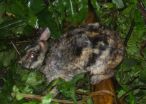(Press-News.org) A rare and elusive rabbit has been found, held and photographed by a researcher from the University of East Anglia (UEA).
The Annamite Striped rabbit, found in the forests of Laos and Vietnam, was first documented by rabbit expert Dr Diana Bell and colleagues from UEA's School of Biological Sciences in the journal Nature in 1999. It has rarely been seen since.
Researcher Sarah Woodfin, who is studying for a Masters in Applied Ecology and Conservation at UEA, set out on a three-month expedition to track the recently-discovered rabbit and study its habitat.
But she didn't expect to see one in the flesh, let alone become the first researcher to hold one in her arms.
Under the tutelage of Dr Bell and in collaboration with a team from WWF Vietnam, she embarked on her trip to study the rabbit - which is named after its home in the Annamite mountains.
She said; "I didn't expect that I would ever see one up close. I thought that if I was very lucky, I might see one from a distance in the forest. I certainly never expected that I would have the opportunity to hold one of these magnificent animals. I was utterly delighted.
"My team and I encountered the rabbit completely by chance on the first night of my trip.
"It was found hopping along a stream bank eating vegetation. One of my team members managed to catch it and brought it back to camp, where we were all able to have a good look at it.
"My first feeling was shock. I recognized it as a striped rabbit as soon as I saw it, as they are very distinctive, but I couldn't believe that they had caught one.
"The rabbit was very handsome, with dark stripes against a pale gold background and a red rump. We were able to take some measurements and photographs before we released it back into the forest.
"I was completely awed by the encounter.
"I had never expected to get so close to the species but it was necessary to take its measurements. The rabbit was bigger than I had anticipated, but light and delicate.
"I have kept pet rabbits since I was five years old so I knew how to handle it safely. It was a lifetime experience."
Images of the rabbit had previously been caught by motion sensitive 'camera traps'. Sarah travelled to the WWF conservation area to survey and analyse the rabbit's habitat and vegetation. She plans to use this information to model the potential distribution of the rabbit which will help further conservation efforts.
She added: "Nothing is known about the Annamite Striped rabbit and it is absolutely fascinating to think that anything I discover about it could be new.
"It is genetically very distinct from other rabbit species. Sadly there is a possibility that this species could be at risk of extinction due to deforestation and hunting. It is therefore extremely important that we understand as much as possible about this species so that we can evaluate its conservation status and implement appropriate conservation measures."
INFORMATION:
The research project is funded by ZGap (the Zoological Society for the Conservation of Species and Populations) and the Thrigby Hall Conservation Fund.
Many aquatic species have a reputation for negligent parenting. Having cast their gametes to the currents, they abandon their offspring to their fate. However, hands-on parenting is taken to a whole new dimension in the Syngnathidae fish family. Instead of leaving the responsibility to the females, seahorse and pipefish males take the pledge to care for their young even before the eggs are fertilized. The females depart soon after placing their eggs directly into the male's brood pouch, leaving the soon-to-be fathers to incubate the developing embryos. Ines Braga Goncalves ...
Cancer has overtaken cardiovascular disease, which includes heart disease and stroke, as the UK's No 1 killer--but only among men, reveals research published online in the journal Heart.
Cardiovascular disease is still the most common cause of death among women, and kills more young women than breast cancer, the figures show.
The researchers used the latest nationally available data (2012-13) for each of the four UK countries and the Cardiovascular Disease Statistics 2014 report compiled for the British Heart Foundation (BHF) to quantify the prevalence of cardiovascular ...
Researchers have developed a score that predicts an individual's risk of dying within 5 years for people aged between 40 and 70 years old in the UK, according to new research published in The Lancet.
The score, which uses measures that can be obtained by simple questionnaires without any need for physical examination, such as self-rated health and usual walking speed, could be used by individuals to improve awareness of their health status, and by doctors to identify high-risk individuals for further treatment, say the authors.
Individuals can calculate their personalised ...
Women aged 50-69 years who attend mammography screening reduce their risk of dying from breast cancer by 40 per cent compared to women who are not screened - according to a major international review of the latest evidence on breast cancer screening.
Overall, women who are invited to attend mammography screening have a 23 per cent risk reduction in breast cancer death (owing to some attending and some not), compared with women not invited by routine screening programmes.
In the UK, this relative risk translates to around eight deaths prevented per 1,000 women regularly ...
ANN ARBOR, Mich. - Day in and day out, for years on end, millions of people with diabetes prick their fingers to test their blood sugar level. And many may wonder if all the careful eating, exercise and medication it takes to keep those levels under control is really worth it.
A major new study should encourage them to keep going for the long haul, to protect their hearts from diabetes-related damage. But it should also prompt them to work with their doctors on other ways to reduce their cardiovascular risk.
The key finding: that keeping blood sugar levels under good ...
Boston, MA - A new study by researchers at Harvard T.H. Chan School of Public Health found that death rates among people over 65 are higher in zip codes with more fine particulate air pollution (PM2.5) than in those with lower levels of PM2.5. It is the first study to examine the effect of soot particles in the air in the entire population of a region, including rural areas. The harmful effects from the particles were observed even in areas where concentrations were less than a third of the current standard set by the Environmental Protection Agency (EPA).
"Most of the ...
Operation IceBridge wrapped up its seventh Arctic deployment on May 21, when NASA's C-130 research aircraft with the mission's researchers and instruments on board departed Thule Air Base in Greenland and headed to NASA's Wallops Flight Facility in Virginia.
This Arctic field season, IceBridge, NASA's twice-yearly airborne survey of polar ice, carried out 33 eight-hour flights during ten weeks, collecting data over sea and land ice regions that have been evolving rapidly over the last decades. The mission also conducted over a dozen international research collaborations ...
Researchers at the University of Toronto (U of T) have uncovered new insights on the genetic causes of Amyotrophic Lateral Sclerosis (ALS), which is also known as Lou Gehrig's disease. These findings could uncover a new way to detect a genetic predisposition to ALS before the disease strikes.
A common mutation associated with ALS is an unstable repeated DNA sequence within the C9orf72 gene that could reach into the thousands. However, it is unknown how many repeats would be sufficient to cause the disease. A way to predict if the number of repeats increases to the damaging ...
In a paper published June 3, 2015 in the online journal PLOS ONE, University of Connecticut researchers Jan-Michael Hessenauer and Jason C. Vokoun, both in the Department of Natural Resources and the Environment, report on fisheries induced evolution (FIE) in recreational fisheries.
Their research compared populations of largemouth bass (Micropterus salmoides) taken from unexploited reference populations in the state of Connecticut and compared their resting metabolic rates (RMR) with populations taken from popular inland recreational fisheries.
Differences among ...
Each summer, Greenland's ice sheet -- the world's second-largest expanse of ice, measuring three times the size of Texas -- begins to melt. Pockets of melting ice form hundreds of large, 'supraglacial' lakes on the surface of the ice. Many of these lakes drain through cracks and crevasses in the ice sheet, creating a liquid layer over which massive chunks of ice can slide. This natural conveyor belt can speed ice toward the coast, where it eventually falls off into the sea.
In recent years, scientists have observed more lakes forming toward the center of the ice sheet ...



